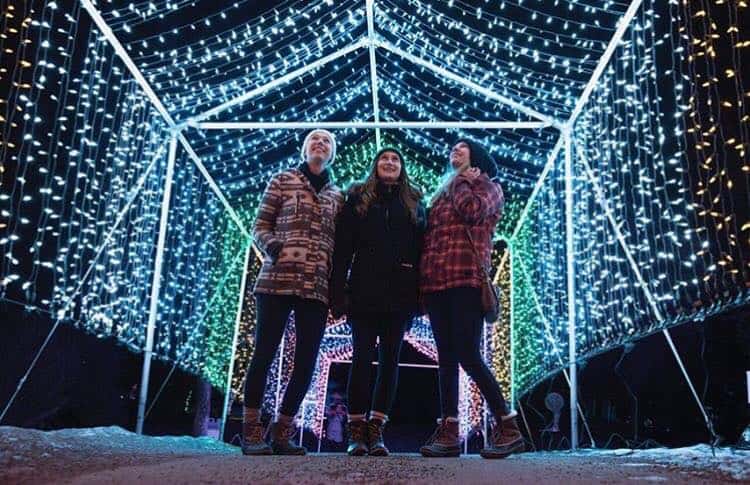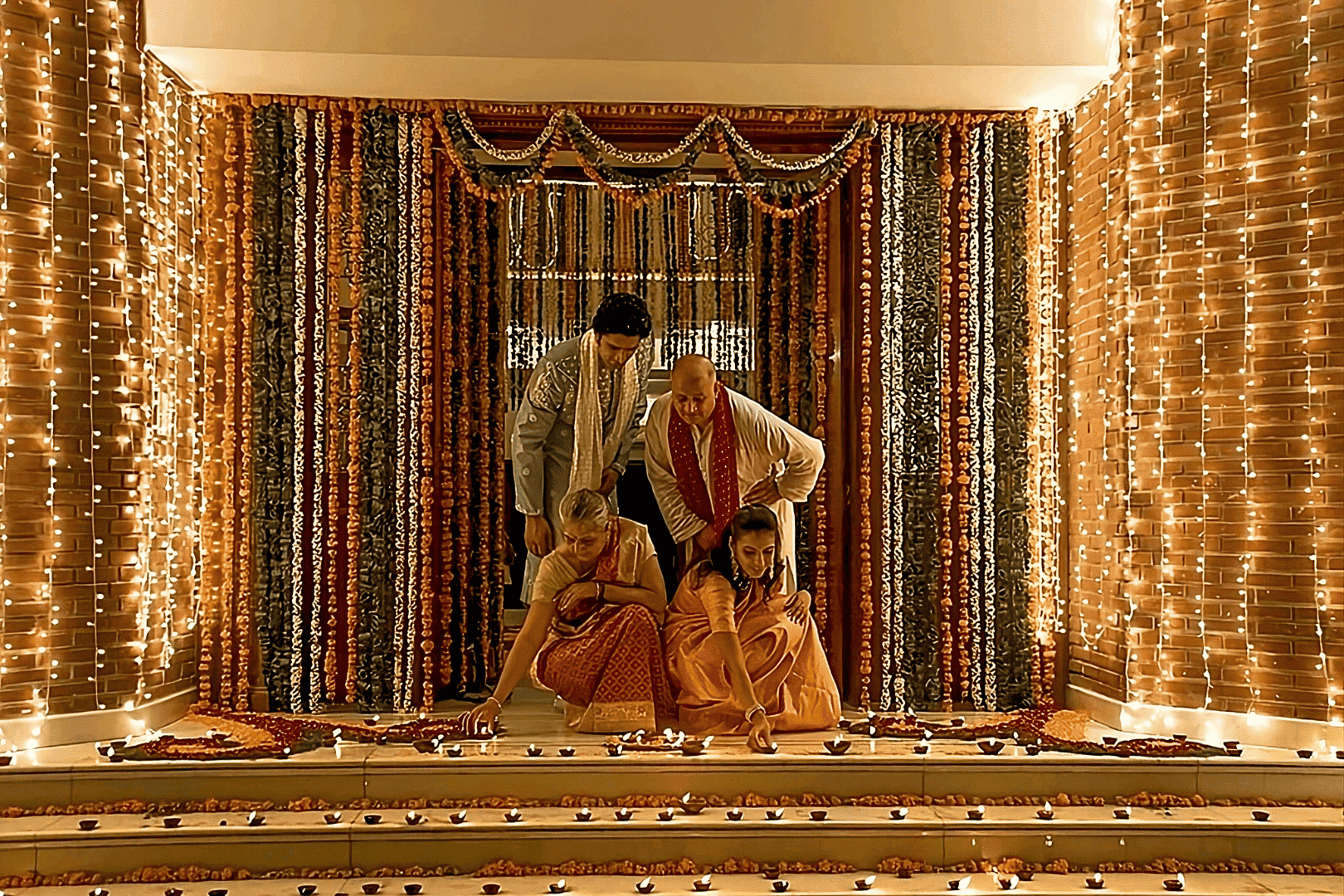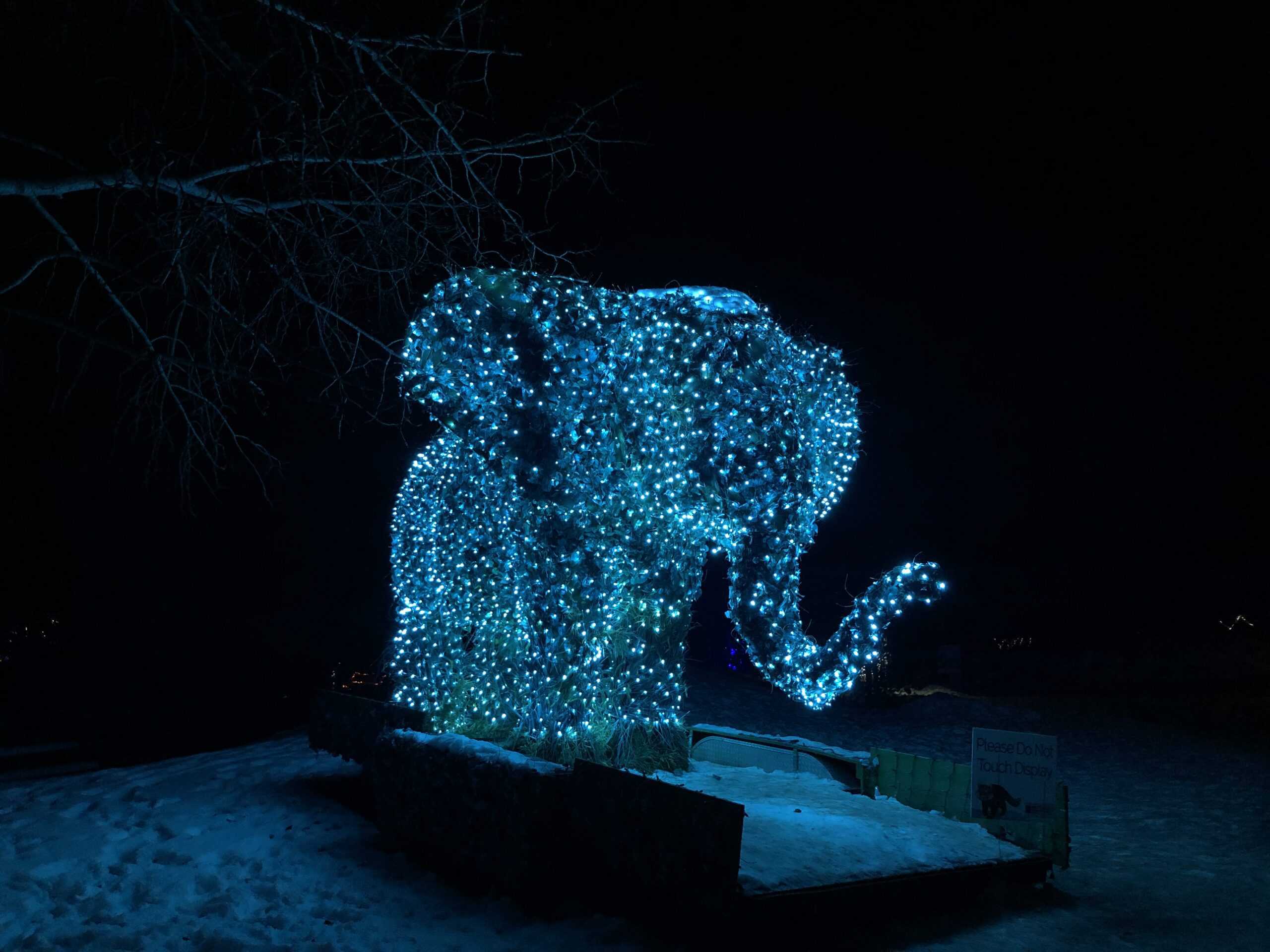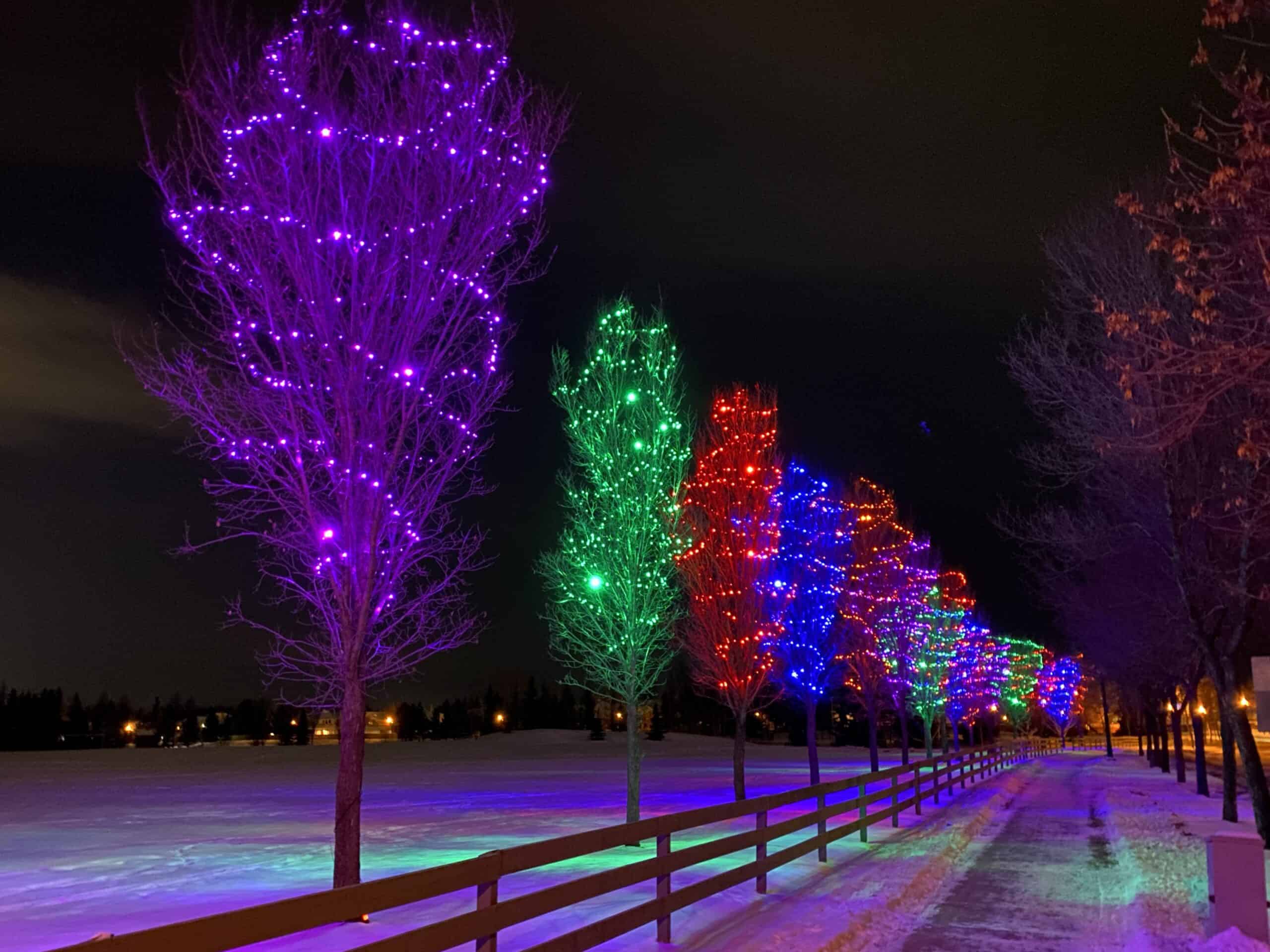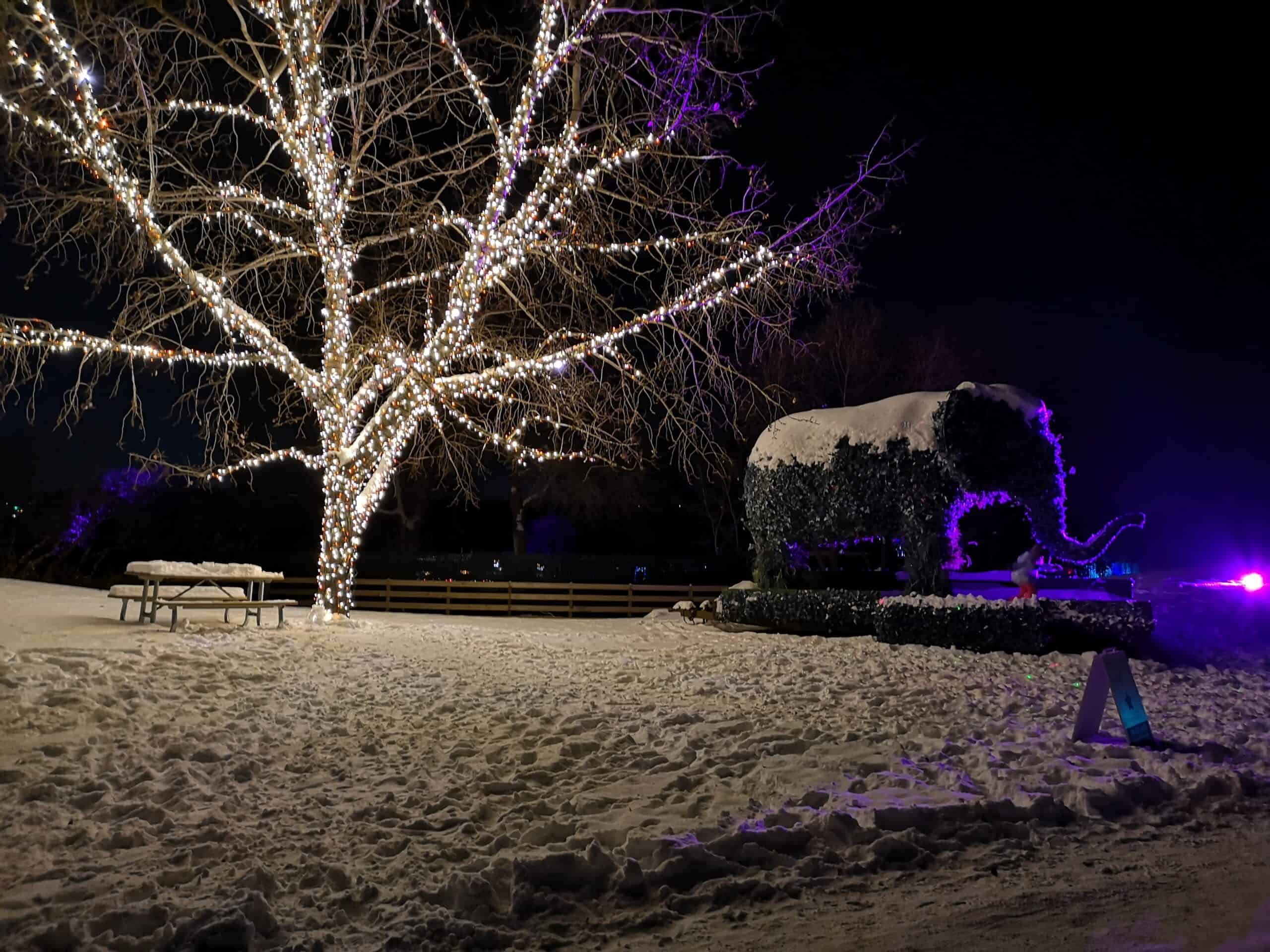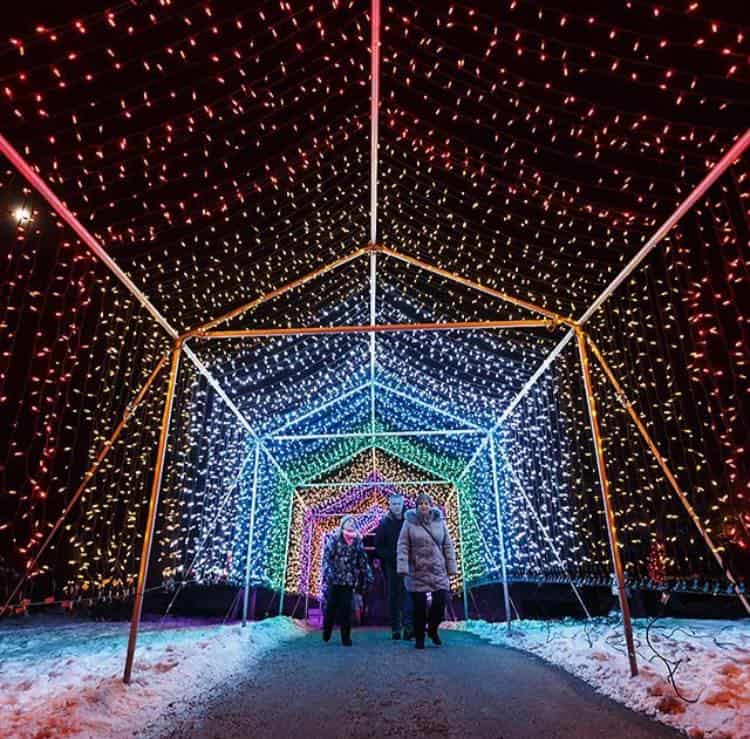Illuminate Your Celebration
If you are looking for dazzling lighting installations for your festival, we are the people for you! Whether your event is an exquisite, high-class event, a lively street performance, or an immersive Christmas experience, we can design and install lighting that perfectly aligns with your vision.
Our team of professional lighting technicians has years of experience in festival lighting. We have worked on a wide variety of projects in this space and have enjoyed each and every one. From gentle, shimmering patterns to bright, large-scale installations, you can be sure of excellent results with Five Star Holiday Décor.
About Holiday Festival Lighting
Stunning light installations can not only brighten up the night landscape but can also attract more visitors to your space or event. Captivate your visitors’ imaginations and promote festivities and celebrations with Five Star Holiday Décor’s premium lighting to make any event unforgettable.
Holiday Festival Lighting Options
Creating brilliant lighting exhibits for local festivals is one of the things we do best here at Five Star Holiday Décor. With years of experience under our belts, we’ll be able to help you create the perfect atmosphere for your holiday event. To discuss specific festival lighting options, please feel free to give our Customer Success Team a call at 780-628-2686. Our options include, but are not limited to the following:
- Tree lighting
- Park lighting
- Street lighting
- Building lighting
- Light tunnels
Benefits of Holiday Festival Lighting
The high quality lights that our team will install will not only beautify your festival venue, but will also provide an added level of safety for your visitors. Beyond this, however, there are many more benefits of getting festival lighting installed by our expert team. These benefits include:
- Increased attendance and engagement for your festival
- Elevated community engagement
- Heightened chances of media coverage for your event
- Higher chances of user-generated content surrounding your festival
- And more!
Cost of Holiday Festival Lighting
The cost of holiday festival lighting varies from project to project and festival to festival. Our team always ensures that we are providing unique, personalized lighting displays and solutions according to your exact needs as our customer. Due to the major differences in each holiday festival lighting package, we provide free, individualized quotes to each of our valued customers, rather than generic pricing. Simply give us a call to get started on your free estimate today!
Our Service Locations
Full Service Festival Lighting
Embrace the enchantment of the holiday season with our expert festival lighting installation services, in Edmonton, Calgary, Airdrie, Cochrane, and Chestermere. Our user-friendly and all-inclusive service simplifies the decoration process, providing ease for homeowners, businesses, and municipalities alike. Allow us to turn your surroundings into a magical wonderland, ensuring that your festival lights radiate brilliance and craft cherished memories that will endure for a lifetime.

Light Up Your Celebratory Event with Premium Designs
Our team of professional lighting experts is ready to take your festival to the next level by lighting up trees, buildings, walkways, and other décor.
Request a Free Estimate Today
Frequently asked questions
We now have an FAQ list that we hope will help you
answer some of the common Festival lighting Installation questions.
1. What is festival lighting, and how does it differ from regular holiday lighting?
Festival lighting is a specialized form of decorative lighting used to enhance the ambiance and atmosphere of various events and celebrations, typically held outdoors or in larger venues. It serves the purpose of creating a festive and inviting environment that aligns with the theme and spirit of the event. Festival lighting is distinct from regular holiday lighting in several ways:
- Event-Specific Design: Festival lighting is tailored to suit the particular event it is used for. Whether it’s a music festival, a wedding, a cultural celebration, or a community gathering, festival lighting is designed to complement the event’s theme, colours, and mood. In contrast, holiday lighting often follows a more standardized or traditional design, centered around the holiday season.
- Versatility: Festival lighting is highly versatile and adaptable to a wide range of events. It can include various types of lighting elements, such as string lights, lanterns, fairy lights, and colourful bulbs, depending on the desired effect. Regular holiday lighting tends to be more focused on traditional elements like Christmas trees, wreaths, and holiday motifs.
- Year-Round Use: While regular holiday lighting is primarily associated with the holiday season, festival lighting can be used year-round for a variety of celebrations and occasions. This flexibility makes it suitable for weddings, outdoor parties, cultural festivals, and other special events that occur throughout the year.
- Customization: Festival lighting allows for greater customization and creativity in design. Event organizers have the freedom to choose lighting colours, patterns, and layouts that align with their event’s unique vision. In contrast, holiday lighting often adheres to established holiday colour schemes and motifs.
- Event Lighting Services: Many event planning and rental companies offer festival lighting as part of their services, providing professional installation and design expertise. In contrast, regular holiday lighting for homes is often DIY or offered by specialized holiday decorating services.Festival lighting is a versatile and customized form of decorative lighting that enhances the atmosphere of various events and celebrations year-round. It differs from regular holiday lighting in its adaptability, design flexibility, durability, and suitability for a wide range of occasions beyond traditional holiday celebrations.
2. What are the available options for festival lighting, including types and styles of lights?
Festival lighting offers a diverse array of options, encompassing various types and styles of lights to suit the unique atmosphere and theme of different events.
When considering festival lighting, you’ll find a wide range of choices, including:
- String Lights: String lights are a popular and versatile choice for festival lighting. They consist of bulbs connected by a flexible cord or wire. String lights come in various bulb shapes, sizes, and colours, making them adaptable to a wide range of event themes.
- Fairy Lights: Fairy lights are delicate, small LED lights typically mounted on thin copper or silver wire. They create a magical and ethereal ambiance, making them well-suited for weddings, garden parties, and whimsical events.
- Bistro Lights: Bistro lights, also known as café lights, are string lights with larger, often globe-shaped bulbs. They are commonly used to create a warm and inviting atmosphere at outdoor events, particularly in dining areas.
- Paper Lanterns: Paper lanterns are decorative lighting elements made of paper or fabric stretched over a frame. They come in various shapes, sizes, and colours, adding a charming and festive touch to events.
- LED Rope Lights: LED rope lights are flexible, tubular lights encased in a durable, clear plastic tube. They are ideal for outlining paths, structures, and architectural features, and they come in various colours.
- Candle Lanterns: Candle lanterns provide a cozy and romantic lighting option. They can be used with real candles or battery-operated LED candles for safety.
- Edison Bulbs: Edison bulbs are vintage-style, exposed filament bulbs that create a warm and nostalgic atmosphere. They are often used for rustic and industrial-themed events.
- Chandeliers: Chandeliers are elegant lighting fixtures that can be suspended outdoors or in event tents to add a touch of sophistication and grandeur to formal occasions.
- Glowing Spheres: Glowing spheres or orbs are spherical lights that can float on water or be hung in trees to create a captivating and enchanting effect.
- Projection Lighting: Projection lighting allows you to display dynamic images, patterns, or colors on surfaces like walls, floors, and ceilings, adding a dynamic and visually stunning element to your event.
- Custom-Made Installations: For a truly unique and personalized touch, you can have custom-made lighting installations designed to match the theme or concept of your festival. This may include large-scale light sculptures, art installations, or custom signage.
- Solar-Powered Lights: Eco-conscious options include solar-powered festival lighting, which harnesses solar energy during the day to illuminate your event at night, reducing environmental impact.
- Colour-changing Lights: Some festival lights offer the ability to change colours and create dynamic lighting effects, adding excitement and versatility to your event decor.
When selecting festival lighting, consider the overall atmosphere you want to create, the event’s theme, and the specific areas you wish to illuminate. Mixing and matching different types and styles of lights can result in a visually captivating and immersive experience that enhances the ambiance of your festival or event.
3. How do I choose the right festival lighting for my specific event or location?
Choosing the right festival lighting for your event or location involves careful consideration of several key factors to ensure that the lighting aligns with the atmosphere, theme, and practical needs of your occasion.
Here’s a step-by-step guide to help you make an informed decision:
- Define Your Event’s Theme and Mood: Begin by clarifying the theme and mood you want to create. Is your event romantic, whimsical, elegant, rustic, or festive? Understanding the desired ambiance will guide your lighting choices.
- Consider the Event Space: Evaluate the layout and characteristics of your event space, including its size, shape, and architectural features. Take note of areas that require illumination, such as pathways, dining areas, and focal points.
- Identify Key Lighting Areas: Determine the specific areas where lighting will have the most impact. These may include entrances, stages, dance floors, dining tables, and decorative elements. Prioritize these focal points.
- Select Lighting Types: Choose lighting types based on your event’s theme and the areas you wish to highlight. For example, string lights work well for a romantic garden wedding, while bistro lights create a cozy atmosphere for an outdoor dining area.
- Opt for Complementary Colors: Select lighting colours that harmonize with your event’s colour scheme and theme. Warm colours like soft whites and amber create an inviting and intimate ambiance, while coloured lights can add vibrancy and playfulness.
- Factor in Energy Efficiency: Consider eco-friendly options, such as LED lights and solar-powered fixtures, which are energy-efficient and sustainable. They can reduce energy costs and minimize your event’s environmental footprint.
- Plan for Safety: Prioritize safety by keeping lighting fixtures away from flammable materials, ensuring proper grounding and secure installation, and using extension cords and power strips rated for outdoor use if needed.
- Lighting Control and Dimming: Consider whether you want the ability to control and dim the lights during different phases of your event. Dimmable lighting can create a dynamic atmosphere.
- Seek Professional Guidance: If you need assistance with installation, consult with our professional lighting designers. Their expertise can be invaluable in creating the desired ambiance.
By carefully considering these factors, you can select the right festival lighting that enhances the overall experience of your event, aligns with your theme, and creates a visually captivating atmosphere that leaves a lasting impression on your guests.
4. What are the energy-efficient and environmentally friendly options for festival lighting?
Choosing energy-efficient and environmentally friendly festival lighting options is not only beneficial for reducing energy consumption but also for minimizing the environmental impact of your event.
Here are some eco-conscious choices to consider:
- LED Lights: LED (Light Emitting Diode) lights are among the most energy-efficient and environmentally friendly lighting options available. They use significantly less electricity than traditional incandescent bulbs and have a longer lifespan. LED festival lights are versatile, come in various colours, and can be used for both indoor and outdoor events.
- Low-Voltage Lights: Low-voltage festival lights operate at a lower power level than standard lighting, reducing energy consumption. They are safe, energy-efficient, and suitable for outdoor use. Low-voltage lighting can include options like 12-volt LED string lights.
- Timers and Motion Sensors: Incorporate timers and motion sensors into your festival lighting setup to control when the lights are on and to conserve energy when not needed. Timers can be programmed to turn lights on and off at specific times, while motion sensors activate lights only when movement is detected.
- Local Sourcing: Source festival lighting from local suppliers and artisans to reduce transportation-related carbon emissions. Supporting local businesses also promotes sustainability within your community.
- Energy Audits: Conduct energy audits to assess and optimize your festival lighting setup. Identify areas where lighting can be more energy-efficient and make adjustments accordingly.
- Lighting Design: Careful lighting design can also contribute to energy efficiency. Focus on highlighting key areas and creating a visually appealing atmosphere without overusing lighting.
- Reuse and Rental: Whenever possible, reuse seasonal festival lighting from previous events or consider renting lighting equipment. This reduces the demand for new materials and minimizes waste. Five Star Holiday Decor offers temporary lighting options with full set-up and take-down service.
- Proper Disposal: Dispose of lighting equipment responsibly. LED lights contain fewer hazardous materials than traditional bulbs, but recycling or disposing of old lights in accordance with local regulations is essential.
By incorporating these energy-efficient and environmentally friendly options into your festival lighting plan, you can create a sustainable and eco-conscious event while reducing energy costs and minimizing your ecological footprint.
5. Can festival lighting be customized to match the theme or colors of my event?
Yes, festival lighting can be extensively customized to align perfectly with the theme, colours, and overall aesthetic of your event. The ability to tailor the lighting to your specific event is one of the key advantages of using festival lighting.
Here’s how you can achieve this level of customization:
- Colour Variety: Many festival lighting options offer a wide range of colours to choose from, allowing you to select hues that match your event’s colour palette. For instance, LED lights come in various colour options, including warm whites, cool whites, and a spectrum of vibrant colours.
- Custom Color Mixing: Some advanced lighting systems enable you to mix colours and create unique colour combinations. This is particularly useful for events with specific colour themes or branding requirements.
- Bulb Styles and Shapes: Festival lighting comes in different bulb styles and shapes. You can choose bulbs that fit your event’s aesthetic, whether it’s vintage Edison bulbs for a rustic theme or globe-shaped bulbs for a classic look.
- Custom Lengths: Festival lights are often available in various lengths and configurations. You can customize the length to suit the dimensions of your event space, ensuring optimal coverage and visual impact.
- Dimming and Intensity Control: For precise control over the lighting ambiance, consider festival lights with dimming capabilities. Adjusting the brightness allows you to create different moods throughout your event.
- Programmable Lighting Effects: Advanced lighting systems offer programmable lighting effects, such as colour transitions, fading, and pulsating. These effects can be synchronized with music or used to create dynamic lighting displays that match your event’s theme or energy.
- Decorative Elements: Festival lighting often includes decorative elements like lanterns, stars, or shapes that can be customized to fit your event’s motif. You can choose from various designs and styles that resonate with your theme.
- Lighting Patterns: Experiment with different lighting patterns and arrangements to achieve your desired look. Whether it’s draping lights overhead, zigzagging them across a space, or creating geometric designs, the possibilities for customization are vast.
- Lighting Design Services: If you’re unsure how to best customize your festival lighting, consider consulting with a professional lighting designer or event planner. They can provide expert guidance and design a lighting scheme that harmonizes with your event’s theme and vision.
By leveraging these customization options, you can transform festival lighting into a tailored and immersive design element that not only matches but enhances the theme, colours, and overall atmosphere of your event.
6. Are there safety considerations and guidelines for installing festival lighting?
Ensuring the safety of festival lighting installations is paramount to protect event attendees, property, and the overall success of your event. To install festival lighting safely, consider the following guidelines and safety considerations:
- Use Outdoor-Rated Lighting: Ensure that all festival lighting used outdoors is designed for outdoor use. Outdoor-rated lights are built to withstand exposure to weather elements like rain, wind, and UV rays. Indoor lights should not be used outdoors unless explicitly labelled for both indoor and outdoor use.
- Check Wiring and Connections: Inspect all wiring and connections before installation. Make sure wires are free from damage, fraying, or exposed conductors. Use outdoor-rated extension cords and power strips that are designed to handle outdoor conditions.
- Securely Mount Lights: Properly secure festival lights to prevent them from falling or becoming a tripping hazard. Use suitable mounting hardware, such as hooks, clips, or stakes, and ensure they are securely anchored to structures or support posts.
- Avoid Overloading Circuits: Be mindful of electrical loads and avoid overloading circuits. Distribute lights across multiple circuits to prevent circuit breakers from tripping or overheating.
- Professional Installation: Consider hiring professionals or experienced technicians for complex lighting installations. They can ensure that installations meet safety standards and code requirements.
- GFCI Protection: Use Ground Fault Circuit Interrupter (GFCI) outlets for festival lighting near water sources, such as fountains or pools. GFCI outlets detect electrical faults and cut off power to prevent electrical shock.
- Height Considerations: When suspending festival lights, consider the height and clearance needed for safe passage beneath them. Ensure that lights are not positioned in a way that could obstruct walkways or pose a hazard to tall guests.
- Weather Monitoring: Keep an eye on weather forecasts, especially if your event spans multiple days. Take precautions to protect festival lights during adverse weather conditions. In strong winds, secure lights to prevent swaying or dislodging.
- Fire Safety: Keep festival lights away from flammable materials such as fabrics, paper, and decorations. Avoid placing lights near open flames, heaters, or heat sources.
- Regular Inspections: Conduct regular inspections throughout your event to identify any damaged or malfunctioning lights. Our team can promptly replace or repair faulty lights to mitigate potential safety risks.
Prioritizing safety during the installation of festival lighting helps create a secure and enjoyable environment for your event attendees. By following these guidelines and considering potential safety hazards, we can minimize risks and ensure that your festival lighting adds to the overall success and enjoyment of your event.
7. What are the typical costs associated with festival lighting installation and maintenance?
The costs associated with festival lighting installation and maintenance can vary significantly depending on several factors, including the scale of your event, the type of lighting used, the duration of the event, and the complexity of the installation.
Here are typical cost considerations to help you budget for festival lighting:
- Lighting Equipment Costs: The primary expense is the cost of the lighting equipment itself. This includes the purchase or rental of festival lights, bulbs, fixtures, and any necessary accessories. Costs can vary based on the type of lighting chosen, such as LED, solar-powered, or specialty lights.
- Labour Costs: Labor costs include wages for the individuals responsible for installing, configuring, and maintaining the festival lighting. The number of personnel required depends on the size and complexity of the installation.
- Design and Planning: If you enlist the services of a lighting designer or event planner to create a customized lighting design, there will be fees associated with their expertise and design services. This cost can vary based on the complexity of the design.
- Electrical Work: If extensive electrical work is needed to accommodate festival lighting, such as installing additional outlets or circuitry, electrical contractor fees should be factored into the budget.
- Power Source: Consider the cost of electrical power required to operate festival lighting. Larger installations with numerous lights may result in higher energy bills. Energy-efficient options like LED lights can help reduce this cost.
- Accessories and Hardware: Accessories like extension cords, clips, hooks, stakes, and mounting hardware may be needed for installation. These costs can add up, especially for larger installations.
- Transportation: If festival lighting needs to be transported to the event site, factor in transportation costs, including rental trucks or delivery fees.
- Maintenance and Repairs: Maintenance costs cover periodic inspections, bulb replacements, and repairs to ensure that festival lighting remains in good working condition throughout the event. Budget for replacement bulbs and spare parts.
- Insurance: Depending on the value and scale of your festival lighting, you may consider event insurance to protect against damage, theft, or accidents. Insurance costs can vary widely based on coverage limits and other factors.
- Permits and Licensing: Some locations or municipalities may require permits or licenses for festival lighting installations. Check with local authorities and budget for any associated fees.
- Event Duration: Longer events may incur higher maintenance and electricity costs. Consider the duration of your event when estimating ongoing costs.
- Removal and Storage: After the event, you’ll need to budget for the removal and storage of festival lighting, especially if it will be reused for future events.
- Labour for Removal: The removal of festival lighting typically requires labor costs as well. This may involve disassembling, detaching, and carefully packing the lighting equipment.
- Emergency Repairs: In case of unexpected issues during the event, having a contingency fund for emergency repairs or replacements is advisable.
It’s important to conduct a thorough assessment of your event’s specific needs and consult with lighting professionals or event planners to develop a detailed budget that accounts for all relevant costs. Keep in mind that festival lighting can greatly enhance the atmosphere and visual appeal of your event, and Five Star Holiday Decor takes care of many of the event details listed above.
8. Are there professional festival lighting installation services available in my area?
These services are typically offered by experienced professionals who specialize in designing, installing, and maintaining festival lighting tailored to your specific needs and preferences.
Here are some key benefits of hiring professional festival lighting installation services:
- Expertise: Professional installers have the expertise and experience to design and execute intricate lighting displays that enhance the ambiance and visual appeal of your event. They are knowledgeable about the latest lighting technologies and trends.
- Customization: They can work closely with you to customize the lighting design to match your event’s theme, colours, and atmosphere. Whether it’s a wedding, corporate event, festival, or community celebration, professional installers can create lighting that fits your vision.
- Efficiency: Professionals are equipped with the necessary tools and equipment to efficiently install and maintain festival lighting, saving you time and effort. They ensure that the installation is done safely and securely.
- Safety: Safety is a top priority for professional installers. They adhere to safety guidelines and best practices, reducing the risk of accidents and electrical issues associated with festival lighting.
- Maintenance: Many professional services offer maintenance packages to ensure that the lighting remains in pristine condition throughout your event. This includes bulb replacements and troubleshooting.
- Dismantling and Storage: After the event, professional installers can handle the dismantling of the lighting and its safe storage if you plan to reuse it for future events.
- Convenience: Hiring professionals takes the stress out of handling lighting installations on your own, allowing you to focus on other aspects of event planning.
- Local Expertise: Local professional installers are familiar with the unique characteristics of your area, including weather conditions and venue requirements. They can make recommendations tailored to your location.
When searching for professional festival lighting installation services in your area, consider reaching out to Five Star Holiday Decor, which is known for its quality and expertise in creating captivating lighting displays. They are now serving Edmonton, Calgary, Airdrie, Cochrane, and Chestermere, making it convenient for residents and event organizers in those areas to access their services.
By collaborating with professionals, you can transform your event space into a magical and memorable experience, leaving a lasting impression on your guests and attendees.
9. What are some creative ways to incorporate festival lighting into event decor and design?
Festival lighting offers endless creative possibilities for enhancing event decor and design, setting the mood, and creating a memorable atmosphere. Whether you’re planning a wedding, outdoor festival, corporate event, or any special occasion, here are some creative ways to incorporate festival lighting into your decor and design:
- Canopy of Lights: Create a stunning canopy of festival lights overhead, draping them between trees or structures. This creates a magical and intimate atmosphere, especially for outdoor weddings or garden parties.
- Fairy Light Curtains: Hang fairy lights vertically to form elegant light curtains. These can serve as photo backdrops, entrance decorations, or dividers between event spaces.
- Pathway Illumination: Use festival lighting to line pathways and walkways, guiding guests safely and adding a touch of enchantment to evening events. Consider options like solar-powered path lights or LED rope lights.
- Tree Wraps: Wrap festival lights around tree trunks and branches to create illuminated trees. This works beautifully for outdoor receptions and garden events, adding a fairytale-like quality.
- Lighting Installations: Consider custom lighting installations or sculptures that complement your event theme. For example, large lighted initials of the couple’s names for weddings or corporate logos for brand events.
- Colour Themes: Embrace coloured festival lights to match your event’s colour scheme. Alternating colours or using colour-changing lights can add vibrancy and drama to the decor.
- Vintage Edison Bulbs: For a rustic or industrial theme, opt for vintage Edison bulbs. Suspend them in clusters or rows to create a warm and nostalgic atmosphere.
- Floating Lights: Place floating lights in pools, ponds, or water features for a captivating effect. These can be LED candles, glowing orbs, or floating lanterns.
- Lighted Backdrops: Use festival lights to create eye-catching backdrops for stages, photo booths, or dessert tables. Incorporate greenery or fabric to enhance the visual impact.
- Bistro Lights Over Dining Areas: Install bistro lights above dining areas for a cozy and inviting atmosphere, reminiscent of alfresco dining in European cafes.
- Interactive Lighting: Incorporate interactive lighting elements that respond to sound or movement. For example, lights that change colour or pattern based on music beats or guest interactions.
- Tent and Ceiling Draping: Drape festival lights along the ceiling or canopy of event tents. The soft glow creates a romantic and intimate atmosphere for weddings and receptions.
- Themed Designs: Customize festival lighting to fit your event’s theme, whether it’s nautical, bohemian, vintage, or seasonal. This personalization enhances the overall decor and ties everything together.
- Gobo Lighting: Use gobo projectors to cast custom patterns, logos, or monograms in light onto walls, floors, or ceilings, adding a unique and branded touch to your event.
- Lighting Pathways: Create guided pathways using festival lights to lead guests to different event areas or attractions, building anticipation and enhancing the overall flow.
- Colour Washes: Illuminate walls or architectural features with coloured lighting washes to create dramatic and dynamic visual effects.
These creative ways to incorporate festival lighting into your event decor and design can transform your space, evoke the desired atmosphere, and leave a lasting impression on your guests. Remember to collaborate with lighting professionals or event designers to bring your vision to life effectively.
10. How can I ensure that festival lighting remains in good condition and lasts for multiple events?
Ensuring the longevity and good condition of festival lighting is essential to make the most of your investment and create consistent, stunning lighting displays for multiple events.
Here are several tips and best practices to help you maintain festival lighting for long-term use:
- Invest in Quality Lighting: Start with high-quality festival lighting equipment. Well-made lights and fixtures are more durable and less likely to fail prematurely. Opt for reputable brands known for their reliability.
- Regular Inspection: Conduct regular visual inspections of your festival lighting before and after each event. Look for damaged bulbs, frayed wires, loose connections, or any signs of wear and tear. Address issues promptly.
- Professional Installation: Hire professional installers who have experience with festival lighting. They can ensure proper installation, which reduces the risk of damage during setup and removal.
- Safe Storage: After each event, carefully remove festival lighting and store it in a dry, climate-controlled space. Protect lights from moisture, extreme temperatures, and exposure to the elements. Coil and organize wires to prevent tangling.
- Use Storage Containers: Consider using storage containers or bins specifically designed for holiday or event lighting. These containers protect lights from dust and physical damage.
- Labelling: Label or mark festival lighting strands, connectors, and accessories for easy identification. This simplifies setup for future events and reduces the risk of mistakes.
- Bulb Replacement: Replace any burned-out or damaged bulbs promptly. Keeping spare bulbs on hand can expedite this process. Make sure replacement bulbs are of the same type and quality as the originals.
- Maintenance Kits: Invest in lighting maintenance kits that include essential tools and replacement parts, such as bulbs, fuses, and connectors. Having these kits on hand makes it easier to address minor issues during events.
- Weatherproofing: If you plan to use festival lighting outdoors, ensure that the lights are adequately weatherproofed. Purchase outdoor-rated lights and connectors, and use weatherproofing materials as needed.
- Securely Store Extension Cords: Store extension cords neatly and securely to prevent tangling and damage. Consider using cord reels or organizers.
- Consult Professionals: If you’re unsure about maintenance or repairs, consult with lighting professionals or technicians who specialize in festival lighting. They can diagnose and resolve complex issues.
- Transportation: If you need to transport festival lighting to various event locations, do so with care. Use padded cases or containers to protect lights during transit.
- Lighting Control: Use lighting control systems, timers, and dimmers to manage the intensity and usage of festival lighting. This helps extend the lifespan of bulbs and reduces energy costs.
By following these maintenance and storage guidelines, you can maximize the lifespan of your festival lighting and ensure that it remains in excellent condition for multiple events.

